The British Shorthair cat is a medium to large-sized pedigreed version of the Domestic British cat, celebrated for their plush, dense coat and iconic appearance. Known for their easygoing and placid temperament, British Shorthairs are adaptable companions that thrive in a variety of households, including those with children and other pets. Their luxurious short coat, which requires minimal grooming, is one of the breed’s defining features, with the classic grey (commonly referred to as “blue”) being the most recognized color. However, British Shorthairs come in a wide range of colors and patterns, including tabby, bi-color, and tortoiseshell. With a history tracing back to the early days of organized cat fancy in Britain, this breed has remained a favorite due to its sweet nature, robust health, and timeless charm.
As companions, British Shorthairs are reserved yet deeply loyal. While not overly demanding of attention, they form strong bonds with their families and are known for their quiet, undemanding personalities. These cats are mellow and patient, tolerating gentle handling and even enjoying occasional cuddles, though they may not actively seek them out. Unlike more active or high-strung breeds, British Shorthairs are calm, grounded, and content to spend their days lounging or observing their surroundings. Their intelligence and adaptability make them easy to train and a joy to have in the home.
When considering a British Shorthair, it’s advisable to prioritize adopting from rescue organizations or shelters to provide a loving home to a cat in need. However, if you decide to purchase, it’s crucial to choose a reputable breeder. Conduct thorough research to ensure that the breeder follows ethical practices and prioritizes the well-being of their cats. Reputable British Shorthair breeders prioritize the health and temperament of their cats, conduct necessary health screenings, and provide a nurturing environment for the kitties.
Quick Facts
- Origin: United Kingdom
- Size: Medium to large
- Breed Group: Short hair
- Lifespan: 12-16 years
- Coat: Short, dense, and plush
- Temperament: Gentle, affectionate, and laid-back
- Exercise Needs: Moderate
- Training: Relatively easy to train
- Grooming: Regular brushing to remove loose hair and dead skin cells.
- Health: Generally healthy, but can be prone to certain genetic health conditions, such as hypertrophic cardiomyopathy (HCM) and polycystic kidney disease.
- Arguably the most famous British Shorthair cat is the Cheshire Cat from “Alice in Wonderland.” They are famous for that enigmatic and mischievous smile.
British Shorthair Pictures
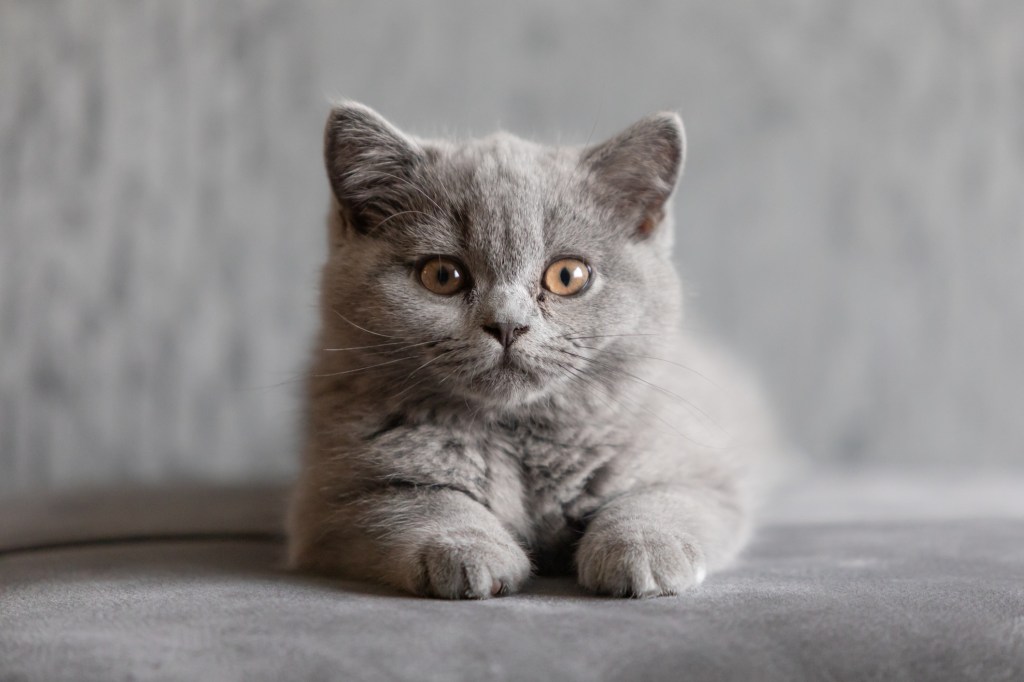
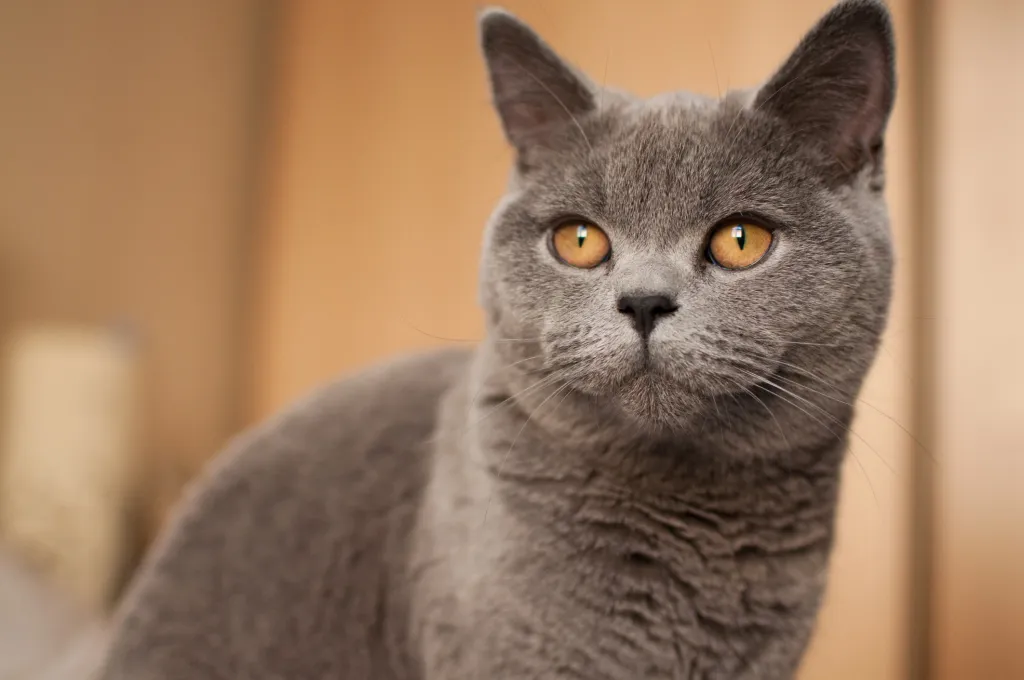
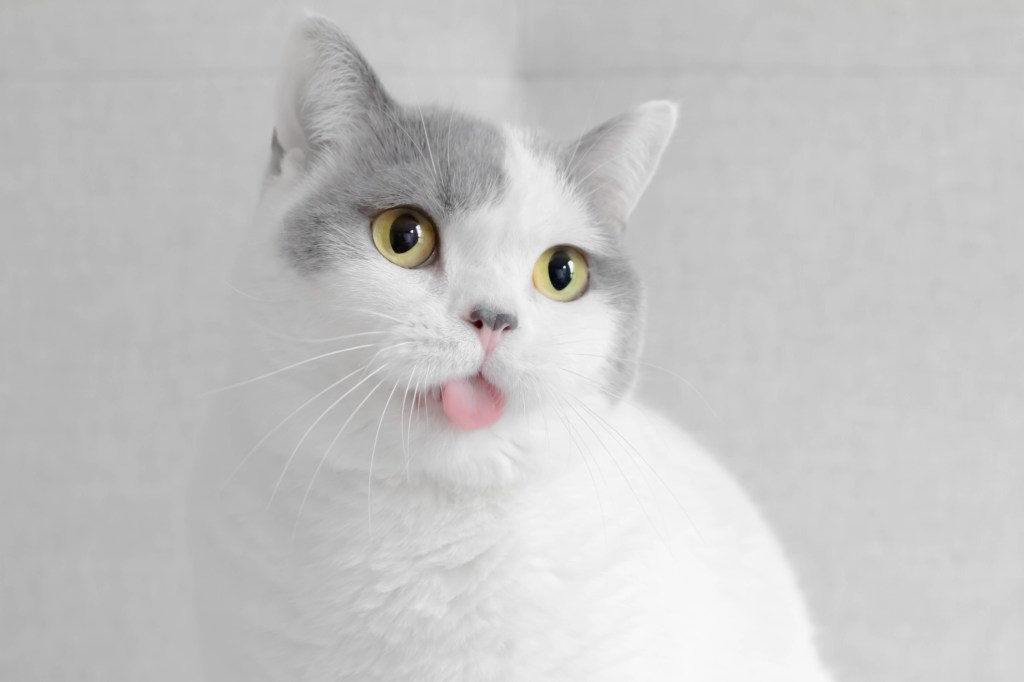
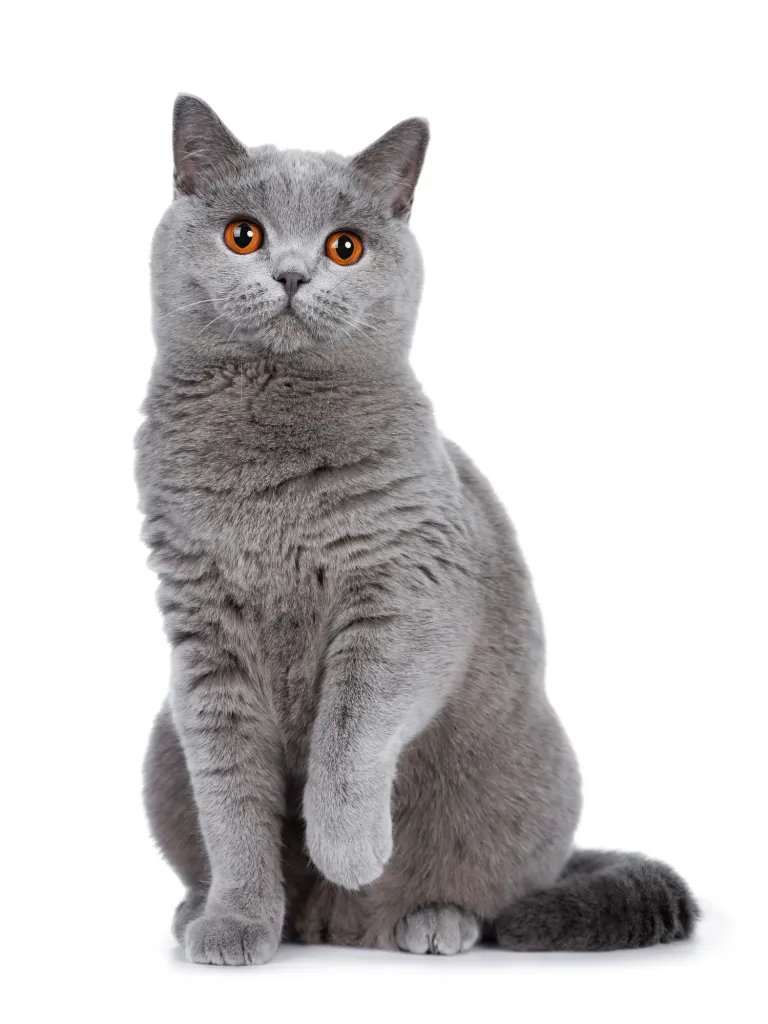
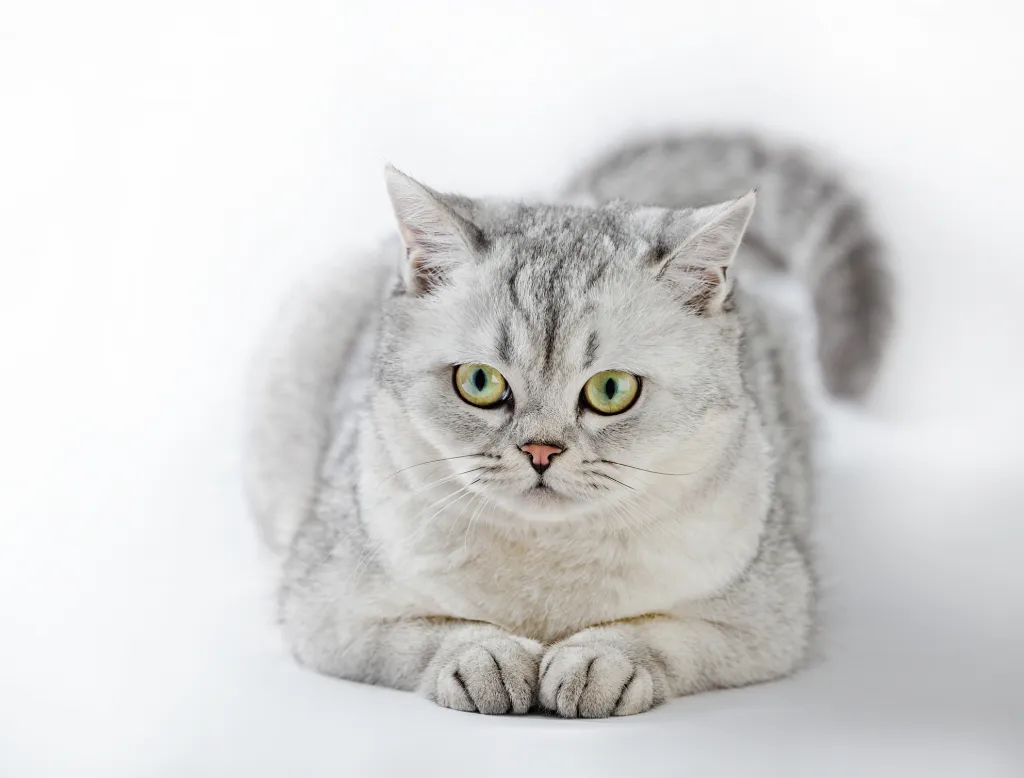
-
Affectionate with Family
Some cat breeds are typically independent and aloof, even if they’ve been raised by the same person since kittenhood; others bond closely to one person and are indifferent to everyone else; and some shower the whole family with affection. Breed isn’t the only factor that goes into affection levels; cats who were raised inside a home with people around feel more comfortable with humans and bond more easily.

See Cats Less Affectionate with Family -
Amount of Shedding
If you’re going to share your home with a cat, you’ll need to deal with some level of cat hair on your clothes and in your house. However, shedding does vary among the breeds. If you’re a neatnik, you’ll need to either pick a low-shedding breed or relax your standards. This furniture cover can make it easier to clean up cat hair and keep it off your sofa!
-
General Health
Due to poor breeding practices, some breeds are prone to certain genetic health problems. This doesn’t mean that every cat of that breed will develop those diseases; it just means that they’re at an increased risk. If you’re looking only for purebred cats or kittens, it’s a good idea to find out which genetic illnesses are common to the breed you’re interested in.
-
Potential for Playfulness
Some cats are perpetual kittens—full of energy and mischief—while others are more serious and sedate. Although a playful kitten sounds endearing, consider how many games of chase the mouse-toy you want to play each day, and whether you have kids or other animals who can stand in as playmates. A classic wand cat toy like this one is perfect for playful felines!
-
Tendency to Vocalize
Some breeds sound off more often than others with meows, yowls, and chattering. When choosing a breed, think about how the cat vocalizes and how often. If constant “conversation” drives you crazy, consider a kitty less likely to chat.
-
Kid-Friendly
Being tolerant of children, sturdy enough to handle the heavy-handed pets and hugs they can dish out, and having a nonchalant attitude toward running, screaming youngsters are all traits that make a kid-friendly cat. Our ratings are generalizations, and they’re not a guarantee of how any breed or individual cat will behave; cats from any breed can be good with children based on their past experiences and personality.
-
Friendly Toward Strangers
Stranger-friendly cats will greet guests with a curious glance or a playful approach; others are shy or indifferent, perhaps even hiding under furniture or skedaddling to another room. However, no matter what the breed, a cat who was exposed to lots of different types, ages, sizes, and shapes of people as a kitten will respond better to strangers as an adult.
-
Easy to Groom
Some breeds require very little in the way of grooming; others require regular brushing to stay clean and healthy. Consider whether you have the time and patience for a cat who needs daily brushing. You should definitely pick up this awesome de-shedding tool for cats of any hair length!
-
Intelligence
Some cat breeds are reputed to be smarter than others. But all cats, if deprived the mental stimulation they need, will make their own busy work. Interactive cat toys are a good way to give a cat a brain workout and keep them out of mischief. This scratcher cat toy can keep your smart kitty busy even when you’re not home!
-
Pet Friendly
Friendliness toward other household animals and friendliness toward humans are two completely different things. Some cats are more likely than others to be accepting of other pets in the home.
British Shorthair History
You may not realize it, but you probably grew up with the British Shorthair. He is the clever feline of Puss in Boots and the grinning Cheshire Cat of Alice in Wonderland. The British Shorthair is native to England. With the rise of cat shows during the Victorian era, cat fanciers began to breed the cats to a particular standard and keep pedigrees for them.
At the earliest cat shows, British Shorthairs were the only pedigreed cats exhibited. All others were simply described by coat type or color. Two world wars devastated the breed, and few British Shorthairs remained after World War II. With the help of other breeds, the Shorthairs, as they are called in Britain, were revitalized. The American Cat Association recognized the British Shorthair in 1967, but the Cat Fanciers Association did not accept it until 1980. Now, all cat associations recognize the breed.
British Shorthair Size
Males weight 12 to 20 pounds, females 8 to 14 pounds.
British Shorthair Personality
The British Shorthair is mellow and easygoing, making him an excellent family companion. He enjoys affection, but he’s not a “me, me, me” type of cat. Expect him to follow you around the house during the day, settling nearby wherever you stop.
Full of British reserve, the Shorthair has a quiet voice and is an undemanding companion. He doesn’t require a lap, although he loves to sit next to you. Being a big cat, he isn’t fond of being carried around.
This is a cat with a moderate activity level. He’s energetic during kittenhood but usually starts to settle down by the time he is a year old. More mature British Shorthairs are usually couch potatoes, but adult males occasionally behave like goofballs. When they run through the house, they can sound like a herd of elephants. British Shorthairs are rarely destructive; their manners are those of a proper governess, not a soccer hooligan. They welcome guests confidently.
British Shorthair Health
Both pedigreed cats and mixed-breed cats have varying incidences of health problems that may be genetic. Problems that have been seen in the Shorthair are:
- Gingivitis: Gingivitis in cats is a common dental issue involving inflammation of the gums. It is primarily caused by the accumulation of plaque, a sticky film composed of bacteria, saliva, and food particles that form on the teeth. When not removed through regular brushing or dental care, plaque can mineralize into tartar (also called calculus), leading to irritation of the gums and subsequent gingivitis.
- Hypertrophic Cardiomyopathy: Hypertrophic cardiomyopathy (HCM) is a common heart condition in cats that affects the structure of the heart muscle. It involves the thickening (hypertrophy) of the heart’s muscular wall, specifically the left ventricle. This thickening can lead to various complications, including impaired heart function and potential heart failure.
- Polycystic Kidney Disease: Polycystic kidney disease (PKD) is an inherited condition in cats characterized by the formation of fluid-filled cysts in the kidneys. These cysts gradually replace normal kidney tissue, leading to a decline in kidney function over time. PKD is most commonly seen in Persian cats but can also affect other breeds and mixed-breed cats.
British Shorthair Care
The British Shorthair’s short, smooth coat is simple to groom with weekly brushing or combing to remove dead hairs. A bath is rarely necessary. Brush the teeth to prevent periodontal disease. Daily dental hygiene is best, but weekly brushing is better than nothing.
Trim the nails weekly. Wipe the corners of the eyes with a soft, damp cloth to remove any discharge. Use a separate area of the cloth for each eye so you don’t run the risk of spreading any infection. Check the ears weekly. If they look dirty, wipe them out with a cotton ball or soft damp cloth moistened with a 50-50 mixture of cider vinegar and warm water. Avoid using cotton swabs, which can damage the interior of the ear.
Keep the litter box spotlessly clean. Cats are very particular about bathroom hygiene. It’s a good idea to keep a British Shorthair as an indoor-only cat to protect him from diseases spread by other cats, attacks by dogs or coyotes, and the other dangers that face cats who go outdoors, such as being hit by a car. British Shorthairs who go outdoors also run the risk of being stolen by someone who would like to have such a beautiful cat without paying for it.
British Shorthair Coat Color And Grooming
With a short, dense coat, a round head with chubby cheeks, large round eyes, and a sturdy, rounded body, the British Shorthair is often compared to a cuddly teddy bear. This breed boasts a compact yet powerful physique, featuring a broad chest, strong legs ending in rounded paws, and a thick tail with a rounded tip. Their balanced and robust build gives them a distinctive, endearing appearance.
The British Shorthair’s coat comes in an impressive variety of colors and patterns, including lilac, chocolate, black, white, pointed, tabby, and more. The most iconic and sought-after color is blue (gray), leading to the affectionate nickname “British Blues” for cats of this hue. Despite their plush and soft coat, British Shorthairs require minimal grooming. These cats are slow to mature, typically reaching their full physical development between 3 and 5 years of age, further adding to their charm as a dignified and timeless breed.
Children And Other Pets
This mild-mannered cat is well suited to life with families with children and cat-friendly dogs. He loves the attention he receives from children who treat him politely and with respect and is forgiving of clumsy toddlers.
Supervise young children and show them how to pet the cat nicely. Instead of holding or carrying the cat, have them sit on the floor and pet him. Other cats will not disturb his equilibrium. For best results, always introduce any pets, even other cats, slowly and in a controlled setting.
British Shorthair Rescue Groups
If you’re also looking for a dog, check out DogTime’s dog breed page!





